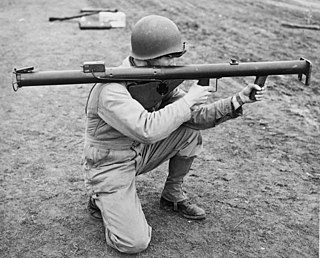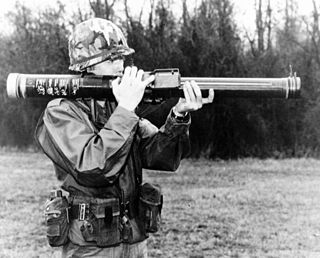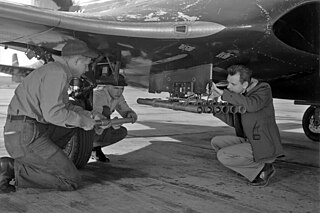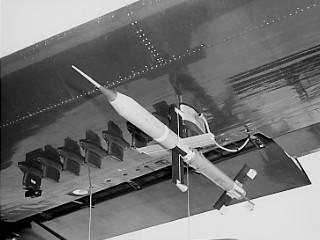
The Bazooka is a man-portable recoilless anti-tank rocket launcher weapon, widely deployed by the United States Army, especially during World War II. Also referred to as the "stovepipe", the innovative Bazooka was among the first generation of rocket-propelled anti-tank weapons used in infantry combat. Featuring a solid-propellant rocket for propulsion, it allowed for high-explosive anti-tank (HEAT) shaped charge warheads to be delivered against armored vehicles, machine gun nests, and fortified bunkers at ranges beyond that of a standard thrown grenade or mine. The universally applied nickname arose from the weapon's M1 variant's vague resemblance to the musical instrument called a bazooka invented and popularized by 1930s American comedian Bob Burns.

Anti-tank warfare originated during World War I from the desire to develop technology and tactics to destroy tanks. After the Allies deployed the first tanks in 1916, the German Empire introduced the first anti-tank weapons. The first developed anti-tank weapon was a scaled-up bolt-action rifle, the Mauser 1918 T-Gewehr, that fired a 13.2 mm cartridge with a solid bullet that could penetrate the thin armor used by tanks at that time and destroy the engine or ricochet inside, killing occupants. Because tanks represent an enemy's strong force projection on land, military strategists have incorporated anti-tank warfare into the doctrine of nearly every combat service since. The most predominant anti-tank weapons at the start of World War II in 1939 included the tank-mounted gun, anti-tank guns and anti-tank grenades used by the infantry, and ground-attack aircraft.

Naval Air Weapons Station (NAWS) China Lake is a large military installation in California that supports the research, testing and evaluation programs of the United States Navy. It is part of Navy Region Southwest under Commander, Navy Installations Command, and was originally known as Naval Ordnance Test Station (NOTS).

The RP-3 was a British air-to-ground rocket projectile introduced during the Second World War. The "3 inch" designation referred to the nominal diameter of the rocket motor tube. The use of a 60 lb (27 kg) warhead gave rise to the alternative name of the "60-pound rocket". Though an air-to-ground weapon, it saw limited use in other roles. They were generally used by British fighter-bomber aircraft against targets such as tanks, trains, motor transport and buildings, as well as by Coastal Command and Royal Navy aircraft against U-boats and ships.

The Zuni 5-inch Folding-Fin Aircraft Rocket (FFAR), or simply Zuni, is a 5.0 in (127 mm) unguided rocket developed by the Hunter-Douglas Division of Bridgeport Brass Company and deployed by the United States Armed Forces, and the French Air Force. The rocket was developed for both air-to-air and air-to-ground operations. It can be used to carry various types of warheads, including chaff for countermeasures. It is usually fired from the LAU-10 rocket pod holding four rockets.

The LBD-1 Gargoyle was an American air-to-surface missile developed during World War II by McDonnell Aircraft for the United States Navy. One of the precursors of modern anti-ship missiles, it was extensively used as a test vehicle during the late 1940s.

The Tiny Tim was an American air-to-ground rocket used near the end of the Second World War.

The NOTS-EV-1 Pilot, better known as NOTSNIK was an expendable launch system and anti-satellite weapon developed by the United States Navy's United States Naval Ordnance Test Station (NOTS). NOTSNIK began as an in-house project using available NOTS funds. The Advanced Research Projects Agency later supplied some funds for the program. The program involved creating transistorized sensors to detect nuclear explosions from the Operation Argus tests. Ten were launched during July and August 1958, all of which failed. It was the first air-launched rocket to be used for an orbital launch attempt; however, none was recorded as having reached orbit. Following the third orbital launch attempt a NOTS engineer at the tracking station in Christchurch, New Zealand reported receiving a weak signal from the spacecraft; This was never confirmed, and the launches were not catalogued as having reached orbit. The Pilot rocket was part of Project Pilot.

The High Velocity Aircraft Rocket, or HVAR, also known by the nickname Holy Moses, was an American unguided rocket developed during World War II to attack targets on the ground from aircraft. It saw extensive use during both World War II and the Korean War.

The Hopi was an air-to-surface missile developed by the United States Navy's Naval Ordnance Test Station. Intended to provide a medium-range nuclear capability for carrier aircraft, the missile reached the flight test stage during 1958, but the project was cancelled following testing and no production was undertaken.

The Bombardment Aircraft Rocket, also known as BOAR, the Bureau of Ordnance Aircraft Rocket, and officially as the 30.5-Inch Rocket, Mark 1, Mod 0, was an unguided air-to-surface rocket developed by the United States Navy's Naval Ordnance Test Station during the 1950s. Intended to provide a standoff nuclear capability for carrier-based aircraft, the rocket entered operational service in 1956, remaining in service until 1963.

The Gimlet was an unguided air-to-air and air-to-surface rocket developed by the United States Navy during the early 1950s. Although it proved successful in testing and was ordered into large-scale production, the arrival of the guided missile as a practical and reliable weapon resulted in the cancellation of the Gimlet rocket in 1957.
The Diamondback was a proposed nuclear-armed air-to-air missile studied by the United States Navy's Naval Ordnance Test Station during the 1950s. Intended as an enlarged, nuclear-armed version of the successful Sidewinder missile, Diamondback did not progress beyond the study stage.

The Creative Research On Weapons or Crow program was an experimental missile project developed by the United States Navy's Naval Air Missile Test Center during the late 1950s. Intended to evaluate the solid-fueled integral rocket/ramjet (SFIRR) method of propulsion as well as solid-fueled ramjet engines, flight tests were conducted during the early 1960s with mixed success.

The 3.5-inch Forward Firing Aircraft Rocket, or 3.5-Inch FFAR, was an American rocket developed during World War II to allow aircraft to attack enemy submarines at range. The rocket proved an operational success, and spawned several improved versions for use against surface and land targets.

The M8 was a 4.5-inch (114 mm) rocket developed and used by the United States military during World War II. Produced in the millions, it was fired from both air- and ground-based launchers; it was replaced by the M16 rocket in 1945.

The AAM-N-5 Meteor was an early American air-to-air missile, developed by the Massachusetts Institute of Technology and Bell Aircraft for the United States Navy. Initially, both air-launched and ship-launched versions were considered. Versions designed for launch from carrier-based aircraft proceeded to the flight testing stage before the project was cancelled.

The ASM-N-6 Omar was a short-range air-to-surface missile developed for and evaluated by the United States Navy in the early 1950s. Intended to use existing unguided rockets as a basis and using a novel guidance system involving optical beam-riding, the program was unable to resolve difficulties with the guidance system and was cancelled without entering service.

SAM-N-8 Zeus, also known as Zeus I, was a project by the Naval Ordnance Laboratory of the United States Navy to develop a guided anti-aircraft artillery shell for launch from 8-inch (200 mm) guns. Tested in the late 1940s, it was overtaken by advances in guided missile technology.



















